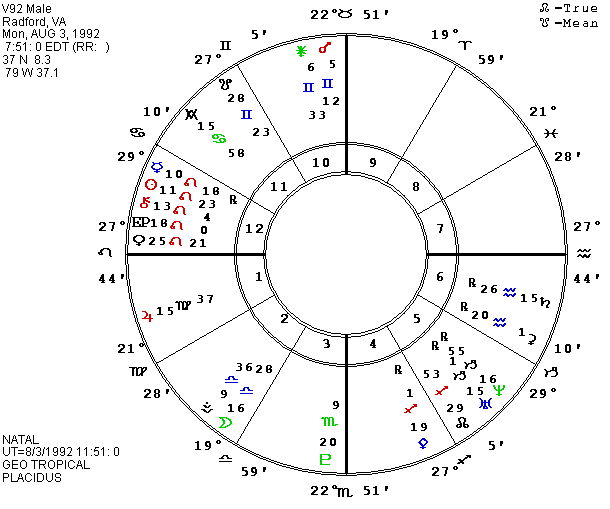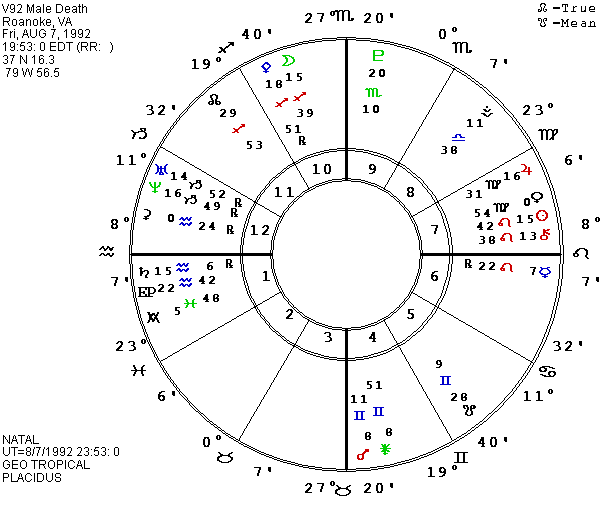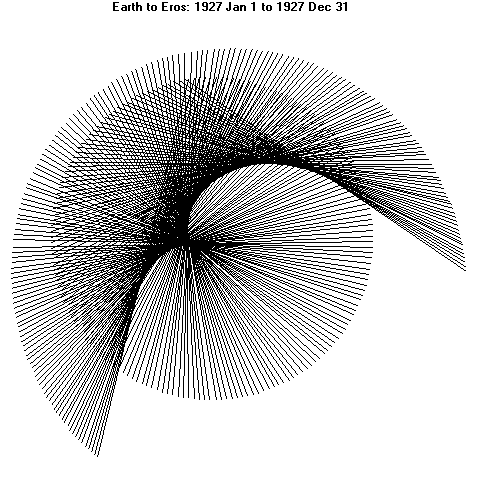A Short Life
Zip Dobyns
A recent Mutable Dilemma Challenge Corner described a family which included twins where one died almost immediately after birth and a sister of the twins died some years later. The next generation of the same family is obviously working on some of the same issues. A baby boy was born on August 3, 1992 at 7:51 A.M. EDT, 37 N 8.3, 79 W 37.1. He died just 4 days later at 19:53 on August 7, 37 N 16.2, 79 W 56.5.
The baby had been taken to a hospital in a nearby larger city, but there was nothing the medical experts could do to save him. He was born with a critical heart defect, with the left side very small and the right side enlarged. Such cases make clear the symbolic nature of astrology. The heart deformity was created long before the baby was born but he “came when he fit” the patterns in the sky, when the horoscope showed the issues and the possible outcome though we could not have predicted with certainty that he would not survive.

The Sun, Leo, and the fifth house are associated physically with the heart and psychologically with self-esteem (a healthy amount of self-love) as well as with the capacity to love others and to accept love from others. The Leo stellium in this chart emphasizes the crucial role of love to the baby, and the aspects clearly highlight the fixed dilemma with oppositions to Saturn in Aquarius and squares to Pluto in Scorpio and the Taurus MC.
Taurus represents our ability to enjoy the physical world on our own terms. On the MC, we may claim some of that executive power for ourselves and have a career involving money, possessions, pleasure, beauty etc. Or we may (especially when we are young) experience the world as having all the power and it may deny our pleasure needs and desires.
Scorpio represents our ability to share possessions, pleasures and power with ongoing partnerships, whether they are personal-emotional or business relationships. Problems in handling Pluto, Scorpio or the eighth house may manifest as power struggles and either the individual or the “partner” may try to take advantage of the other person, to gain personal pleasure at the expense of the other, instead of both enjoying mutual pleasure. Where a parent is involved with a child, clearly the parent has more power, and Scorpio on the fourth house cusp describes one of the parents. If the Scorpio principle is handled properly by the parent, he or she teaches the child to share pleasure and power with others by personal example. A mishandled Scorpio on the MC or IC may indicate a parent who has not learned to respect the rights of other individuals and child-abuse is possible as occurred with the father of the previously discussed twins and their sister.
Aquarius marks the capacity to detach from the possessiveness of the other fixed sides of life, to be personally free and to allow others to be equal and free. Saturn is a co-ruler of Aquarius, and when its lessons (the rules of the game) have been learned, its placement in Aquarius can indicate someone who has internalized the necessary rules as a conscience and can both give and receive freedom. We don’t need external rules and authority figures to enforce them when we have internalized the important ones which permit us to survive in this world and which protect the rights of others.
The fixed dilemma can involve an infinite variety of issues around the handling of pleasures and power, from internal struggles around self-indulgence versus self-mastery to external power struggles with others around possessions and/or pleasures or around freedom versus closeness or dominance versus equality. The problems in the fixed parts of life are further accentuated in this chart by the quincunxes between several of the factors in Leo and Uranus (a ruler of Aquarius) and Neptune (which is both in the Leo house and a ruler of the Scorpio house). Uranus and Neptune also square the Moon in the Taurus house and the Antivertex in the Aquarius house completes a T-square in cardinal signs but in fixed houses. So, including Neptune’s rulership of the Scorpio house, we get the equivalent of a second grand cross in fixed areas when we look at the house placements and rulerships. These patterns illustrate how one can see a theme in a chart.
Except for the MC and Ascendant, the factors in fixed signs in this chart are in mutable houses, so we also have a mutable dilemma which brings in mental issues. One of the most common forms of the mutable dilemma is the conflict between our capacity to cope mentally with the ordinary world around us (Gemini and Virgo, third house and sixth house, and Mercury) versus our desire for something more ideal (Sagittarius and Pisces, ninth house and twelfth house, Jupiter, Neptune, and Chiron). Other indications of links between faith and love or power were shown by the Sun’s conjunction with Chiron (similar to Jupiter) within two degrees and its exact conjunction with the north node of Neptune and its opposition to Neptune’s south node.
The planetary nodes and midpoints involving planets with each other and with the angles of the chart are among the ways that themes can be seen, as the chart keeps repeating the same messages. One of the newest additions to Mark’s CCRS astrology computer program is a printout of the midpoint “trees” which are used a lot by Uranian and Cosmobiology astrologers. The baby’s chart has really dramatic midpoints aspecting the natal Ascendant. Conjunct the Ascendant within one degree are Mars/Pluto (personal power versus shared power), Vesta/Antivertex (efficient functioning including health and another form of personal power), Mercury/Jupiter (this world meeting faith and ideals), Juno/Pluto (both forms of letter eight, the ability to share the world), and Sun/Jupiter (personal confidence versus faith in a higher power). Square the Ascendant within one degree are Vesta/Uranus (functioning in this world versus being free from any limits) and Vesta/Neptune (functioning competently in this world versus escaping to a higher one).
Mutable Dilemma readers will recall that the father of the children who died (who were described in the Gemini 1992 Mutable Dilemma) had preached in a fundamentalist church but abused his own children at home. This included sexual abuse of the daughters when they reached puberty. The charts of the children who died had some of the same issues we can see in this baby’s chart, involving the handling of pleasure and power (fixed issues) but also faith and trust (mutable issues). In this chart, we see conflict aspects from the twelfth house of faith in a higher power to Pluto, ruling the fourth house of a parent, and to Saturn, the natural ruler of the tenth house of a parent. Neptune’s square to the Moon, which is usually a key to one’s mother, is an additional pointer to the issue of faith and a parent. Both the rulers of the tenth house are in the twelfth house, another link between faith and a parent.
If we had not known the family history, we could have speculated endlessly on the possible details of these issues. The baby might have (in a previous life) developed too much faith in his parents and had to learn that they couldn’t “save” him if he had not done his part in developing a reasonably functional heart. He might have worshiped love, made it an idol, and had to learn practicality or just to find a “bigger” God. But the first house Jupiter in Virgo in a trine to Uranus-Neptune in Capricorn does not look like someone seriously lacking in practicality, and Mars in the tenth house is another sign of identification with the material world at the beginning of life. If the individual had, himself, been guilty of the abusive use of power in past lives, it would seem more likely that he would have survived infancy to experience abuse as a child in order to learn that it is not a constructive use of power. But he was identified with power with the fixed emphasis added to the Capricorn, so, regardless of the details of his past handling of these issues, if we had counseled him (or his parents) we would have emphasized the importance of his finding a constructive way to achieve love, power and prominence without turning them into idols and without having to put other people down in order to build himself up or satisfy his own desires. He did have strong air in his chart, in addition to the fire-earth and fixed emphasis which is characteristic of a “steam-roller” individual. So I think if his physical heart had not been beyond redemption, he could have learned to understand and accept others and to share life as an equal while achieving considerable success in the material world.

The transits at the death of the baby are clearly appropriate for his departure from the physical body. T Sun had moved into the exact opposition to Saturn and quincunxes to Uranus and Neptune. The opposition and the quincunx both tend to be separation aspects. T Moon was aspecting much of the natal chart, square Jupiter, quincunx the Antivertex, sextile Moon and Saturn (at their midpoint) and trine T Sun, octile Ceres and the natal Part of Death which was closely conjunct natal Ceres and semisextile Uranus-Neptune (which it had squared in the natal chart). The T MC squared the natal Ascendant and the T East Point squared the natal MC. The T Antivertex squared natal Mars and Juno. The T Part of Death at 15 Scorpio 40 formed a T-square to Saturn and T Sun. (I calculate this Arabic Part with Placidus houses.) T Venus had moved into exact trioctiles to Uranus-Neptune, quincunxes to Ceres-Part of Death, and octiles to Moon and Antivertex.
Many more aspects might be listed, including some interesting heliocentric positions. H Mars was close to a trine to the Ascendant at birth, from Aries in the ninth house. It had moved into an exact trine at the death. I suspect that the baby was glad to get out of that non-functional body and travel to a spiritual world. H Pluto was exactly conjunct the IC at the birth and remained within the one degree orb to the death. The T Ascendant was opposite T Mercury at death and H Chiron maintained an opposition to natal H Mercury while T H Mercury had moved to 29 Aquarius where it was sextile-trine the mean lunar nodes and ready to slip into Pisces as the baby retreated to the spiritual world. Transiting H Venus and H Jupiter were exactly conjunct each other and trine H Pluto and the natal IC, further supporting the indications that he was glad to be taking that “trip.” I suspect that, sometimes, the major lesson from an early death is being learned by the parents. So if any readers want to send prayers and blessings, send them to all of our unnamed subjects.
